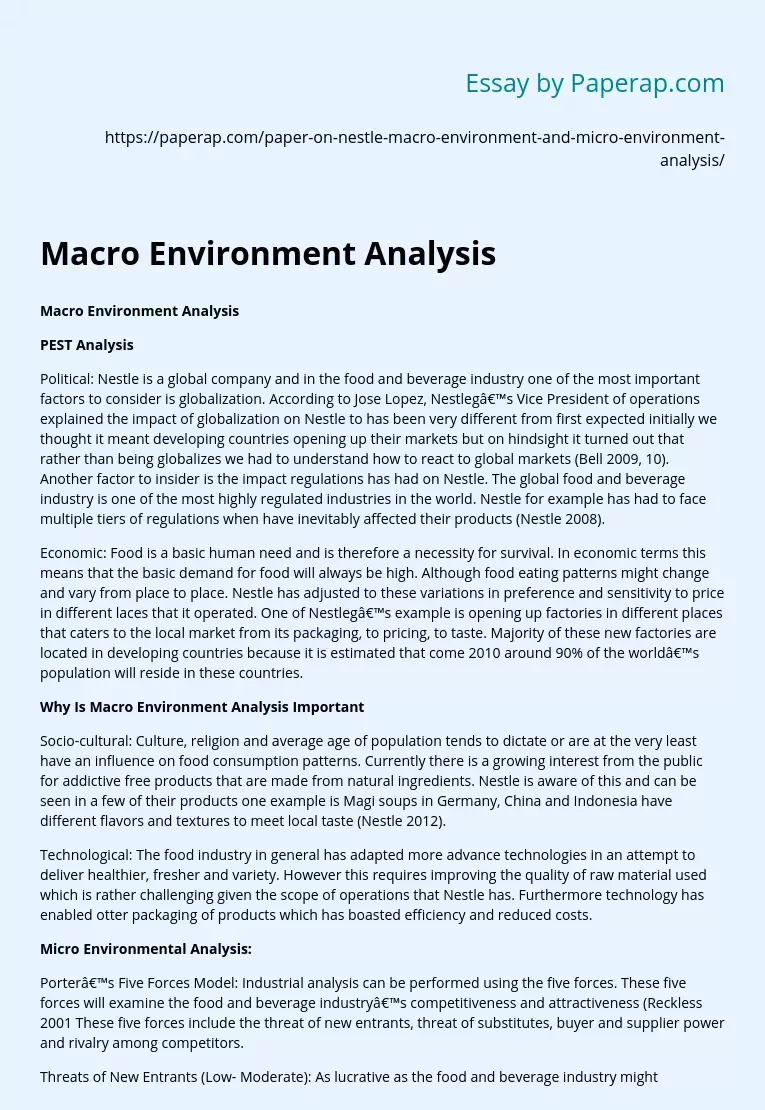Macro Environment Analysis
Macro Environment Analysis
PEST Analysis
Political: Nestle is a global company and in the food and beverage industry one of the most important factors to consider is globalization. According to Jose Lopez, Nestleg’s Vice President of operations explained the impact of globalization on Nestle to has been very different from first expected initially we thought it meant developing countries opening up their markets but on hindsight it turned out that rather than being globalizes we had to understand how to react to global markets (Bell 2009, 10).
Another factor to insider is the impact regulations has had on Nestle. The global food and beverage industry is one of the most highly regulated industries in the world. Nestle for example has had to face multiple tiers of regulations when have inevitably affected their products (Nestle 2008).
Economic: Food is a basic human need and is therefore a necessity for survival. In economic terms this means that the basic demand for food will always be high.
Although food eating patterns might change and vary from place to place. Nestle has adjusted to these variations in preference and sensitivity to price in different laces that it operated. One of Nestleg’s example is opening up factories in different places that caters to the local market from its packaging, to pricing, to taste. Majority of these new factories are located in developing countries because it is estimated that come 2010 around 90% of the world’s population will reside in these countries.
Why Is Macro Environment Analysis Important
Socio-cultural: Culture, religion and average age of population tends to dictate or are at the very least have an influence on food consumption patterns.
Currently there is a growing interest from the public for addictive free products that are made from natural ingredients. Nestle is aware of this and can be seen in a few of their products one example is Magi soups in Germany, China and Indonesia have different flavors and textures to meet local taste (Nestle 2012).
Technological: The food industry in general has adapted more advance technologies in an attempt to deliver healthier, fresher and variety. However this requires improving the quality of raw material used which is rather challenging given the scope of operations that Nestle has. Furthermore technology has enabled otter packaging of products which has boasted efficiency and reduced costs.
Micro Environmental Analysis:
Porter’s Five Forces Model: Industrial analysis can be performed using the five forces. These five forces will examine the food and beverage industry’s competitiveness and attractiveness (Reckless 2001 These five forces include the threat of new entrants, threat of substitutes, buyer and supplier power and rivalry among competitors.
Threats of New Entrants (Low- Moderate): As lucrative as the food and beverage industry might be there are several barriers that make the retreat of new entrants low-moderate. These include the high start up capital required, supply-side economies of scale, unequal access to distribution channels and the demand-side benefits of scale. However it has to be noted that several firms still enter this industry and because of Nestleg’s high market share, they have become a constant target.
Power of Buyers (High): The power of buyers in the food and beverage industry is high. This is because typical buyers are large retailers like Wall-Mart, Carefree etc. These retailers are financially strong and prefer to have long term agreements with market layers. Furthermore majority of buyers are integrated backwards, while several retailers offer their own branded food and beverages.
Power of Suppliers (Low): The power of supplies in this industry is low because of the sheer number of available suppliers and markets to purchase from. It is important to point out that the raw materials in question here are fruits, meat, fish, grains and cereals just to name a few which can easily be purchased in open markets as well. Furthermore some firms have integrated backwards and produce their own raw material handicapping the suppliers rather (Bradley et al. 005).
Threat of Substitute (High): Given the lack of switching cost between alternative for the consumer and the availability of cheaper alternatives to packaged food this has caused the threat Of substitutes to be high (Bradley et al. 2005; Hager n. D. ).. The industry has experienced a surge in private label products and organic food which has caused consumers to experiment with new products.
Rivalry amongst Existing Competitors (High): The food and beverage industry is vast creating more opportunities for market players.
Macro Environment Analysis. (2019, Dec 05). Retrieved from https://paperap.com/paper-on-nestle-macro-environment-and-micro-environment-analysis/

